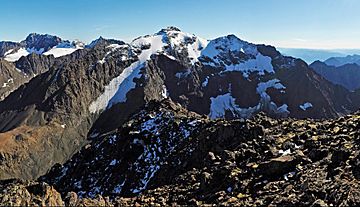Calliope Mountain facts for kids
Quick facts for kids Calliope Mountain |
|
|---|---|

Northwest aspect, from Cantata Peak
|
|
| Highest point | |
| Elevation | 6,821 ft (2,079 m) |
| Prominence | 981 ft (299 m) |
| Isolation | 2.1 mi (3.4 km) |
| Parent peak | Eagle Peak |
| Geography | |
| Location | Chugach State Park Anchorage Municipality, Alaska United States |
| Parent range | Chugach Mountains |
| Topo map | USGS Anchorage A-7 |
| Climbing | |
| First ascent | 1967 |
| Easiest route | Scrambling class 4 |
Calliope Mountain is a tall mountain in the Chugach Mountains of Alaska. It stands at 6,821-foot (2,079 m) high. You can find it in Anchorage Municipality, inside Chugach State Park. The mountain is about 20 mi (32 km) east-southeast of downtown Anchorage. It's also 2.1 mi (3 km) southwest of Eagle Peak, which is a nearby, even taller mountain.
How Calliope Mountain Got Its Name
The first people to climb Calliope Mountain were W.E. Hauser and B.P. Hansen. They reached the top on June 24, 1967. They wanted to name it "Icy Peak." But their friends at the Mountaineering Club of Alaska had a different idea. They suggested a name that would fit with the musical theme of the area.
There are many mountains and lakes nearby with music-related names. For example, within three miles, you can find Symphony Lake, Concerto Peak, Flute Peak, Triangle Peak, Organ Mountain, Cantata Peak, and Hurdygurdy Mountain. So, the name Calliope was chosen. A calliope is a musical instrument that makes sounds like an organ. The United States Board on Geographic Names officially adopted the name in 1969.
Weather and Glaciers
Calliope Mountain is in a subarctic climate zone. This means it has very cold, snowy winters and mild summers. Temperatures can drop below −20 °C (that's -4 °F!). With the wind chill, it can feel even colder, sometimes below −30 °C (-22 °F).
This cold climate helps two small, unnamed glaciers form on the mountain's north side. You can also find the Flute and Organ Glaciers to the east. If you want to climb or just see Calliope Mountain, the best time to visit is usually from May through June. During these months, the weather is most favorable. All the rain and melting snow from the mountain flow into streams that eventually join the Eagle River.


